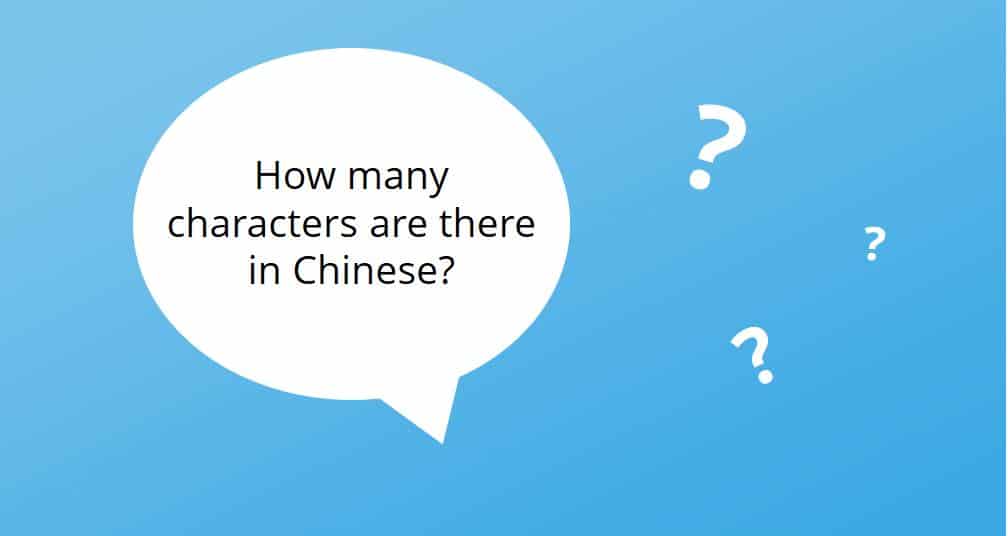How many Chinese characters do I need to learn? You may have wondered that when starting Mandarin, as many many learners do when embarking on the wonderful journey that is learning Chinese. Read on to know the answers to these essential questions and all about Chinese characters. Besides learning how many characters there are in Chinese, you’ll see how many the average Chinese knows and how much you need to learn to reach conversational fluency in Chinese!
It’s quite normal when you’re starting out in Mandarin to wonder how many characters and words are there exactly in Chinese? And then, to wonder immediately after that, just how many of those Chinese characters do I need to learn? The task may seem daunting, the number of Chinese characters that exist is enormous, but after you read this post, I can assure you that you’ll know exactly how many and how to find Chinese characters to learn. We’ll see first what the Chinese language is made of, then, how many Chinese characters you need to know and finally the amount of characters natives know.
How many characters exist in total in Chinese?

What is the Chinese language made of? Nowadays, the Chinese language is made of more than 80,000 characters, 85,568 characters to be more precise according to the Zhonghua Zihai dictionary. The 中华字海 Zhonghua Zihai dictionary contains all the Chinese characters that have ever existed, from old Buddhist texts to characters used by the Qing, Ming and Song dynasties. Such a very complete dictionary! It sounds very impressive, but you should know that a lot of the characters contained in this dictionary are actually no longer used.
So now you know that there are at least 80 000 characters in Mandarin. But it doesn’t stop there! These 80 000 characters equal many, many, more Chinese words. How does that work?
In the Chinese language, 字 zì characters also known as 汉字 hànzi (hanzi) meaning Chinese characters can be combined together to create 词 cí words. Yes, you heard right.
Single characters can be words on their own, for instance, you can use the character 手 shǒu hand if you want to talk about someone’s hand but most words in Chinese are composed of two or more characters. So if you take this character 手 for example, you can combine it with other characters to create new words like 手表 Shǒubiǎo wristwatch.
The Chinese language works in an interesting way, doesn’t it? It’s a little tricky.
This means if you “only” learned the 80,000 Chinese characters, you’d be able to understand a good number of the words you run across in a text, but not all of them. It’s often possible to guess the meaning of two characters combined together to form a new word, but often, it’s not possible, as you’ll see below.
Let’s take the characters 手 and 机 and their pinyin.
手 shǒu hand
+
机 jī machine
= 手机 shǒujī cellphone
You can easily guess the meaning of the word 手机 in simplified Chinese when you know the meaning of each individual character.
On the contrary, here’s a tougher word to crack, using the characters 上 and 手:
上 shàng above
+
手 shǒu hand
= 上手 shàngshǒu to master
See? The Chinese word 上手 made of the two characters 上 and 手 is harder to guess! And if you don’t know the characters you’ll hardly guess the word’s pronunciation.
🏮 Ninchanese is an incredible app for learning Chinese! 🏮
” I actually graduated from the University of Edinburgh with a MA in Chinese.
I’ve used Ninchanese daily, and it has helped me a lot! “
– Connor, Ninchanese User
Try Ninchanese, an award-winning method to learn Chinese today:
Start Learning Now
This is why you should master both Chinese characters and terms, to be able to understand the texts you run into in China.
So how many Chinese words are there in Chinese? That’s an even tougher question than how many Chinese characters are there. As Chinese is a living language, it’s hard to give a definite count. The Chinese language is still evolving and new terms and expressions are created every day. To give you an idea, The 汉语大词典 Hanyu Da Cidian (lit: Comprehensive Chinese Word Dictionary) is said to contain 370,000 words. Just like the 中华字海 Zhonghua Zihai dictionary for characters, a lot of the entries in the 汉语大词典 are no longer in use.
You know now how to identify Chinese characters (one syllable max) and words (one or more 字). But are you worried by the sheer quantity of words that exist in Chinese? We have some good news for you: there is no need to memorize all 80,000+ Chinese characters or 370 000 Chinese words. All you have to do is master the characters and terms which are commonly used today in the Chinese language. Conversational fluency in Chinese is within your reach and won’t take years and years of study. Relieved? I’m sure what you’re really itching to know now is: So, how many Chinese characters will I need to learn to be able to handle most texts in everyday circumstances?
How many Chinese characters do you really need to learn?
Many people are afraid of learning Chinese because of the 80,000 characters that make up the Chinese language. It seems like a lot to learn. The truth is you don’t need to know that many characters to speak Chinese. Did you really believe that Chinese natives all know 80,000 characters? Nope! Not at all. Native Chinese speakers themselves don’t know that many words and characters in Chinese! That’d be an incredible amount of terms to know. So before we move on to how many Chinese words and Chinese characters you would be required know to be considered fluent, let’s see first how many characters an average Chinese speaker knows.
In elementary school, Chinese pupils are expected to learn about 2,500 characters which are the most used. Then they assimilate about 1,000 more specific ones during middle school and high school. In the end, Chinese students that have finished high school know about 4,500 characters. For reference, the Chinese government puts literacy at 2000 characters. Well-educated Chinese people know anywhere from 8,000 characters and upwards. That’s really far away from the 80,000 Chinese characters! Only specialized linguists and scholars get closer to those 80,000.
4500 to 8000 characters to know doesn’t sound too bad, right? So how many Chinese characters do YOU need to know to be considered fluent? The number of Chinese characters and words you need to know depends on many things such as your learning goal, your current fluency level or even the frequency of use of these characters.
What’s your learning goal for Chinese?
First, ask yourself what’s your goal in speaking Chinese? What are you looking to do? If you want to live in China, and simply interact in your everyday life in Chinese, a working vocabulary of 1000 words might be enough to start with. You don’t need to learn many characters to travel to China. If you need to order food, read something that’s written on a menu, call a taxi or even asking for a direction, few survival words would be enough. If you want to understand what’s going on TV, on the radio or in the newspapers, you’ll basically need to learn about 3,000 to 4,000 characters. In newspapers you’ll find about 2.500 very common Chinese characters, so knowing 3,000 characters will allow you to understand about 99% of what’s written.
Now if your goal is to be able to read a Chinese dictionary, which is a pretty advanced Chinese goal, then you’ll need to know at least 9,000 to 15,000 characters to be able to comfortably read the definitions.
Having a Chinese learning goal is essential to progress, but knowing what level you are is also very important to know what Chinese characters and terms to learn.
What’s your level?
You’ve just started learning Chinese? Then you belong to the HSK 1 level which requires learning about 150 words. You’ve just entered the world 3 in Ninchanese? Then you’re the HSK 3 level and you’ll need to learn about 300 new terms. Check your level and see how many words you have to learn according to the HSK. As there has been a renewal of the HSK exams.
The numbers of words you need to learn for the new HSK:
HSK 1: 153 – HSK 2: 150 – HSK 3: 300 – HSK 4: 598 – HSK 5: 1300 – HSK 6: 2513

The HSK levels are important if you want to prove your Chinese skills by taking the exam, it’s also good for you to know where you are and where you’re heading to. But don’t rely on them, as some terms in the lists are sometimes quite odd, and not that useful on a daily basis.
Pick the right characters to learn: Mind the characters’ frequency
Learning every single Chinese character would be a waste of time as you’ll rarely meet some of them. Why don’t you learn the characters that are the most used in everyday life? Here’s the list of the most frequent characters. See? Currently, the most used Chinese character is 的 de of; particle. If you master the most frequent Chinese characters, you’ll be in theory able to read a newspaper, have a conversation, watch TV and so on. It just depends on how many frequent characters you decide to learn. If you digest 100 of the most common characters, you statistically should have a 42% understanding of the characters you run into.
1000 of the most frequent Chinese characters should bring you an 89% understanding of what you read.The caveat to this method is that the 11%, for instance, you won’t understand will be the characters that bring you the meaning of the sentence. Imagine being able to read everything single word in a sentence that says “I bought an XXX for cheap”. If you don’t know what XXX means, then the sentence is rather pointless isn’t? The best way to counter that is to keep expanding your Chinese vocabulary, by learning new characters, and more specific terms you’re interested in, and more specific until you’ve learned the 3000 to 4000 most frequent Chinese characters. Then, you should be familiar with the vast majority of the characters you running into.
My advice : Do a little bit of everything
Pay attention to these three steps to know what and how many characters you should learn. My best advice would be to put as a goal: master 2,500 to 3,000 characters. Therefore, you’ll be able to understand many things. When you’re HSK 4 level (world 4 in Ninchanese), you should be able to understand about 2,000 characters and terms. But how and what should you learn? In Ninchanese, we help you learn the most common and frequently used Chinese characters. So, take the road to world 4 and you’ll be on the right path to speaking Chinese like a native!
Final words:
Now that you know how many terms and characters exist in Chinese, and how many characters you need to learn, aren’t you glad you asked? You see, there’s no need to be scared of some mischievous Chinese characters! You don’t need to assimilate an entire Chinese dictionary by heart to be fluent in Chinese, just follow our advice, and you’ll soon be learning the Chinese words and characters you need to reach your goal of fluency in Chinese!
Learning words and characters is the key to reading anything you see and fitting in China! The cool thing about Chinese characters is that they are the writing system common to all forms of spoken Chinese. See, you could be learning one of the many dialects of the Chinese language (check out this page to learn more about them), you’ll still be using Chinese characters.
Let’s say, for instance, that you want to learn Cantonese, as Olly Richards did in one year, can you guess what writing system you’ll be using? That’s right, Chinese characters. No matter what spoken form of Chinese you’re learning, you’ll be using them in writing. So it’s pretty important to learn Chinese characters and really, there’s no need to be afraid of learning them.
Just pick your main learning goal, be realistic in the number of terms and Chinese characters you want to learn based on your actual level and select the characters that are the most frequent if you want to save time and efficiently study Mandarin. We’ve already selected the words you should know in Ninchanese so learn Chinese at your own speed without thinking about what you need to learn. After all, most of the Chinese only know about 5,000 characters and we know you soon will too!
Now tell us, how many words do you think you know in simplified Chinese? Or have you stopped counting?
The Nincha Team
Stay in touch with us on Facebook, Twitter, Instagram, and Pinterest.
Try the best way to learn Chinese today.
Ninchanese is free to use!
Sign up now






19 comments
Join the conversationPingback: The Best Free Chinese Dictionaries For Learners - Ninchanese
Pingback: Mandarin Weekly #72 – Mandarin Weekly (每周中文)
Pingback: New Beta Update: More Words for Ninchanese - Ninchanese
Pingback: Top 10 Activities to Keep Learning Chinese This Summer - Ninchanese
Pingback: Mandarin Weekly #72 - Startupnet
Pingback: Phonetic Components: Your Secret Trick to Guessing the Pronunciation of Chinese Characters - Ninchanese
Pingback: Ask Nincha: Tone sandhi - Why are there tone changes in Chinese?
Gustavo Reis - January 5, 2017
If I want to develop a pan-CJK font, will I build 85 thousands or only 8 thousands?
The Nincha Team - January 7, 2017
Hi Gustavo, well, that depends on what you’re building a font for! What are you planning on doing with it?
Gustavo Reis - January 7, 2017
I intend to build two fonts, one handwriting and another sans-serif art deco. I want to build unified pan-CJK (Chinese (including Simplified and Traditional), Japanese and Korean) characters. Completing an omniglot font is my ambition. I know it is not possible to unify them because the four different variants of each characters follow the same unicode, therefore, I have to use stylistic sets to make easier. A web font OTF and OTF features sets are already supported in the most of browsers due to the popularity of HTML5.
I know Chinese has over 8 thousands glyphs, Japanese over 4,5 thousands and Koreans has few characters.
— Iosekva, an open source monospaced font, has 35 thousands glyphs.
— M+ Fonts, an open source Japanese font, has 4,5 thousands glyphs.
— Noto CJK, an open source Google fonts family, has 65 thousands glyphs.
— Source Han Sans, an open source CJK Adobe fonts family, has 65 thousands glyphs.
But make me know that it is unnecessary to build all the simplified and traditional Chinese glyphs because not all people from China and Taiwan use the computer for typography or not all speak all the glyphs. Suggest me how glyphs I should build or I should build the same that Iosekva or Adobe’s and Google’s.
Pingback: Learn Chinese by Adapting the Spaced Repetition System in Real Life - Ninchanese
Pingback: 5 things that are keeping you from improving in Chinese - Ninchanese
Pingback: How many Chinese characters/words do you need to know? | Omniglot blog
Techtipntrick - March 3, 2020
So, what do you choose, using a badly drawn and inaccurate map, or entering a strange and perhaps dangerous labyrinth, trying to understand how it works? I think that the answer depends much on how much you have studied (i.e. how strange the labyrinth is) and what your goal is. If you re short of time, running around in labyrinths all day isn t a good idea, although you might have to do that sooner or later anyway. If you re happy as long as you learn Chinese, strolling in the labyrinth is excellent.
Pingback: Writing Chinese characters: The purpose - Ninchanese
Isaac - March 7, 2020
If you think 上手 means ‘to master’, then it is a Japanese word. In Chinese, nowadays 上手 means ‘start to do [something]’. In the past, it means ‘a seat for very important gust(on the left side of the host)’.
APKun - April 22, 2020
This app is the perfect “addon” for my Pleco Chinese dictionary. Pleco for the serious learning and homework word lookups, and Ninchanese for gamified learning on the go.
Worries - April 22, 2020
Now, you’ll practice making sentences by dragging and dropping characters in the correct place. You’re given the sentence in English and you have to make the correct sentence in Chinese. Sounds easy right? I struggled with it. So, if you just learned the difference between ?, now is the time to see how well you really understood what you read.
Med Advice - April 23, 2020
There is a set number of words to learn in each of these sections. This fluctuates pretty significantly from lesson to lesson. The very first lesson of the first world of Ninchanese only has five new words. Other lessons may have over 60 words for you to learn. Of course, learning 60 words can take some time and you can’t move ahead to the other lesson components before completing this.
Comments are closed.